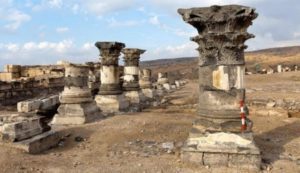
The Hippos-Sussita Excavations Project, under the auspices of The Zinman Institute at The University of Haifa, Israel, was initiated in the year 2000. Since then, an international team has excavated for one month each a year, totaling 15 excavation seasons to date at the site of ancient Hippos-Sussita. The last three seasons yielded some surprising finds that allow us to better understand the Hippos necropoleis, religion, public building complexes and the final stages of a major regional polis devastated by the 749 CE earthquake.
Excavations thus far have unearthed a wealth of Hellenistic, Roman, Byzantine and Umayyad structures erected during a period of a thousand years – from the 2nd century BCE to the 8th century CE.
From the beginning of the 2nd century BCE, the land that contains present-day Israel was ruled by the powerful Seleucid kings, rulers of a Greek–Macedonian kingdom that was created from the eastern conquests of Alexander the Great. In order to strengthen their hold on the various regions under their imperial rule, they founded new cities to contain a Greek-speaking and Hellenized Syro-Phoenician population that regarded itself as the bearers of Greek culture. From its very inception, Hippos (which means ‘horse’ in Greek) was a polis in all respects. When the Romans assumed control over the eastern seaboard of the Mediterranean (from 63 BCE onwards), Hippos became one of the ten cities – the Decapolis – that comprised a particular settlement group which included, among others, Gadara (today Umm Qais in the Kingdom of Jordan) as its southern neighbor, and Scythopolis (today Beth Shean in Israel) to the southeast, on the western bank of the River Jordan. These cities were highly influential centers of Greek culture within a region almost entirely populated by people of Semitic origin. The hostility between a gentile Hippos and a Jewish Tiberias on the opposite side of Lake Kinneret was notorious in ancient times.
During the Pax Romana that extended from the end of the 1st century BCE until the end of the 2nd century CE, Hippos enjoyed a long period of florescence and prosperity. Most of the magnificent public buildings, still in evidence today in their ruined state, were erected in the city during that time, such as the forum, basilica, kalybe, temple, odeion, and others.
The Christianization of the Roman Empire in the 4th century CE did not bypass Hippos. The eight churches built there during the Byzantine period (4th to 7th century) are clear proof of the conversion of Hippos and its citizens to Christianity. The Arab conquest in the first half of the 7th century was not inimical toward the Hippos population, which continued to conduct their lives normally. Among the ruins in Hippos are a few structures and agricultural installations built during the Umayyad period.
But on January 18, 749 CE, the region suffered a violent and devastating earthquake. The damage it caused Hippos was so severe that all its citizens abandoned it, never to return. The dramatic evidence of the violent destruction can still be seen in the ruins today.
At the end of the First World War (1918), when the British and French marked the borderlines between the Palestine under the British Mandate and Syria under the French Mandate, Sussita Mountain was included within the mandatory borders of Palestine. It is now a part of the modern state of Israel.
The Hippos Excavations Today
Sussita Mountain, upon which the city was built, is located about 2 km east of the shores of the Sea of Galilee, overlooking the lake and the Galilee to its west and the southern Golan Heights to its east. The mountain rises to a height of about 350m above the lake and about 200m above its surroundings, making it a prominent feature in the area. The crest of the mountain is long and narrow in shape, descending slightly from east to west. The length of the crest is about 550m along a southeast-northwest axis and the width is about 150m at the center of the crest.
The mountain is almost cut off from the surrounding area by three riverbeds that flow around it. On the western side, where the mountain slopes toward the Sea of Galilee and its surrounding valleys, an ancient path snakes gradually downward from the mountain crest. In only one place, on the southeast side, is the mountain attached to its surroundings—a natural geologic saddle ridge connecting Sussita with the southwestern slopes of the Golan Heights. It is here that the main road was paved to the east gate, the main entrance to the city.
________________________________________
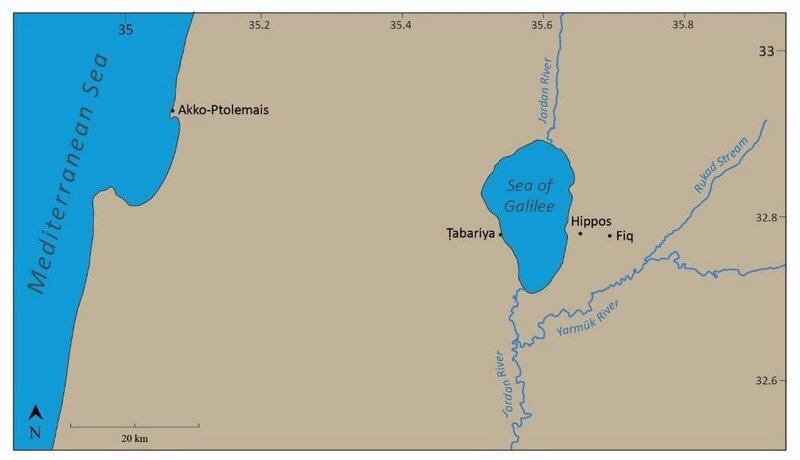 Hippos within its geographic context near the Sea of Galilee.
Hippos within its geographic context near the Sea of Galilee.
__________________________________________________
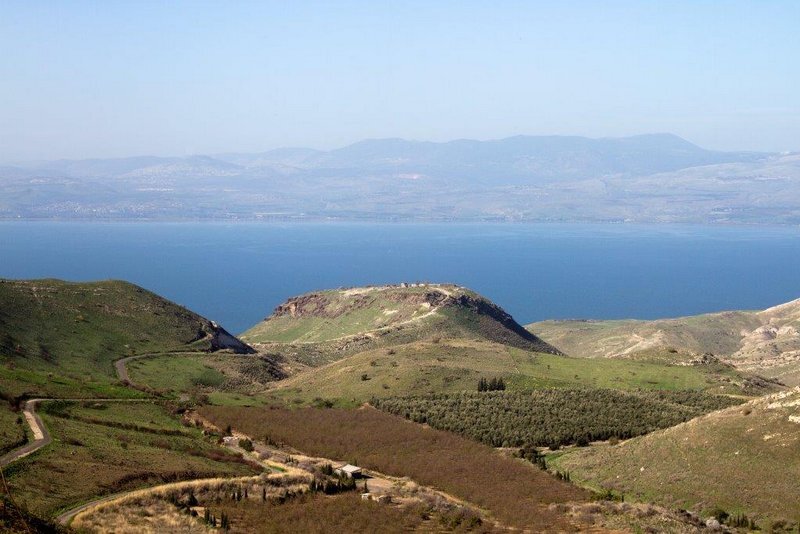 Sussita Mountain and the Sea of Galilee. View from the Golan Heights (photo M. Eisenberg).
Sussita Mountain and the Sea of Galilee. View from the Golan Heights (photo M. Eisenberg).
__________________________________________________
The Necropoleis
Recent surveys and excavations in the vicinity of Sussita Mountain made it clear that there is much more to be found in Hippos’ necropoleis. We have recently discovered a new necropolis, excavated a mausoleum and exposed the settlement’s first burial tombs with portraiture, affording a better understanding of the world of the dead at Hippos.
During a small-scale excavation south of the Sussita saddle ridge we located a tomb stone in secondary use which most probably originated in the nearby necropolis, south of Hippos. It was the first find of a portraiture of a Hippos man—a roughly depicted bust of a man wearing a toga within an aedicula on a basalt stone, likely dated to between the 3rd and 4th centuries CE.
The main necropoleis are set on a hill and a wadi just south of Sussita, to the east of the mountain and along the saddle-ridge. It was here that the main road to the city was paved, leading to the main east city gate. A field of sarcophagi, which contains hundreds of hewn rectangular graves and a series of mausolea (elaborate tombs with their upper stories highly decorated), were built along the ridge but did not cross the ditch that was cut in the middle of the saddle ridge. The ditch, though created purely for protective reasons, marks the limit of the urban boundary of Hippos, and it is only from this area and beyond that burial was permitted anciently.
A square mausoleum, 7.5 x 7.5m, was built of basalt ashlars in the Roman period (2nd century CE) and was in use until the Byzantine period (6th century CE). The mausoleum consists of a lower vaulted chamber supporting its upper story. The lower chamber was found to include family members’ sarcophagi, and the upper story was highly decorated and seen by everyone crossing the main road toward Hippos. The architectural fragments found here, made of the local basalt, are of superb craftsmanship. The best designed piece found here is a small Ionic corner capital of a pilaster. The rest of the pilaster drums are scattered around the building and down into the nearby wadi. One of several recovered fragments of the sarcophagi lids is made of limestone and features a crouching lion at its crown. We have located some of its remains, mainly the lion’s head, which features a protruding tongue that makes the image perhaps more amusing than threatening.
We hope to one day reconstruct this mausoleum, one of a few dozen that were erected along the main road leading to the city’s main east gate.
______________________________________
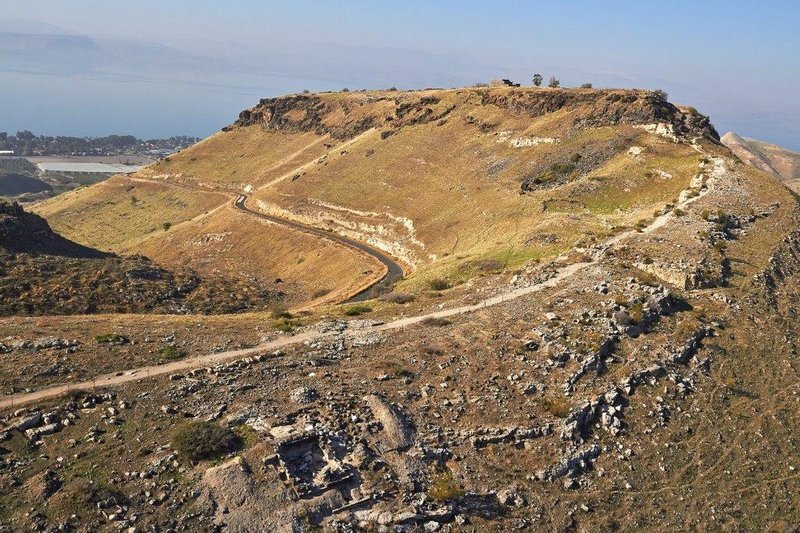 Sussita Mountain as seen from the saddle ridge towards the crest. The mausoleum, the ditch and the round tower area are visible (photo M. Eisenberg).
Sussita Mountain as seen from the saddle ridge towards the crest. The mausoleum, the ditch and the round tower area are visible (photo M. Eisenberg).
_________________________________________________
 The mausoleum on the saddle ridge (photo M. Eisenberg, photogrammetry. E. Gerstein).
The mausoleum on the saddle ridge (photo M. Eisenberg, photogrammetry. E. Gerstein).
_________________________________________________
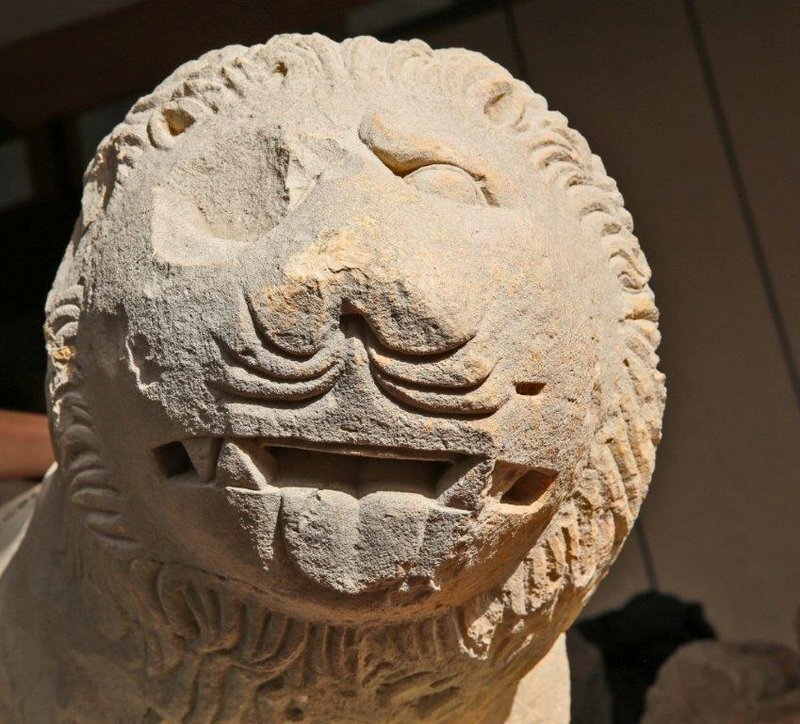 Lion head that adorned sarcophagus lid from the mausoleum (photo M. Eisenberg).
Lion head that adorned sarcophagus lid from the mausoleum (photo M. Eisenberg).
____________________________________________________
 Y. Vitkalov from Haifa Uni., leaning on an Ionic corner capital of a pilaster from the mausoleum (photo M. Eisenberg).
Y. Vitkalov from Haifa Uni., leaning on an Ionic corner capital of a pilaster from the mausoleum (photo M. Eisenberg).
___________________________________________________
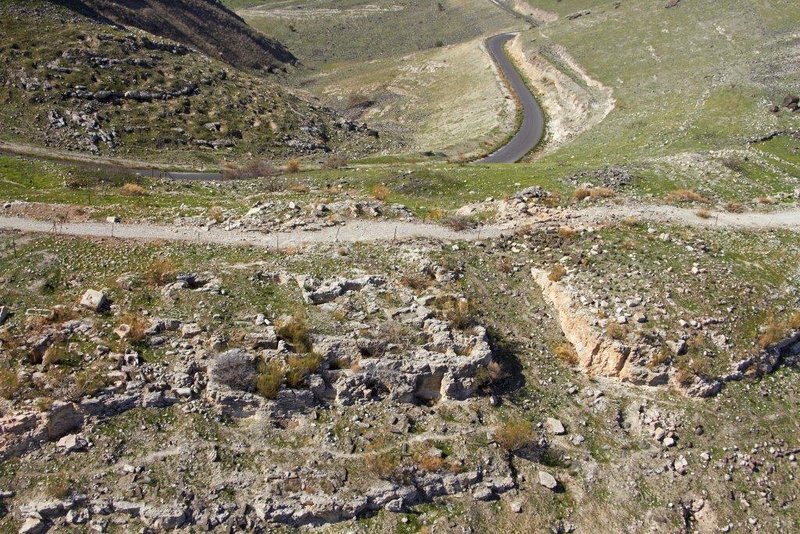 The ditch cut in the middle of the saddle ridge. On the left a field of graves.
The ditch cut in the middle of the saddle ridge. On the left a field of graves.
________________________________________
The Faunus of Hippos
It is only recently that we decided to embark on excavating the northwestern side of the saddle ridge, in between the major excavation seasons. Our hypothesis was that here were a series of basalt structures which were part of the city’s lower defense system, connected with the ditch above it. In such case, these outworks would have served as protected hangers for the Hippos defenders’ projectiles (catapultae and ballistae alike) against besieging forces advancing on the ancient road to the west. We concentrated our efforts on the southernmost of this series of structures. To date, we have exposed a large round tower with an outer diameter of 10 m, its lower courses built of basalt and the upper ones of limestone. It appears to have been part of a bathhouse complex in its second phase; however, its lower courses have not yet been exposed, so it is too soon to determine if it served as a defensive position in its original plane. A fraction of a ballista ball was found in the towers’ debris. We have located about ten of these in various sizes in Hippos so far, but this stone was unique. It was the only one made of hard limestone—not the usual local basalt. It is probable that this ballista ball was shot by the besiegers and broke upon impact.
As good fortune would have it, perhaps the most surprising find thus far at Hippos was located in this area. While clearing the area to excavate another basalt structure located beneath the ditch, Dr. Alexander Iermolin, head of the conservation laboratory at the University’s Institute of Archaeology, heard a faint humming sound coming from the metal detector he was operating. Whatever it was, it was relatively large for a metal finding, buried just above one of the plaster floors of a large, well-built basalt tower with 2 m thick walls. Exploring further, we pulled out a big brown lump and realized it was a large metal mask. We cleaned it, and began to distinguish some details. Hints of its identity began to emerge when we could see small horns on top of its head, slightly hidden by a forelock. Horns like these are usually associated with Pan, the half-man, half-goat god of the shepherds, music and pleasure. Or it could be a satyr. A more thorough cleaning in the lab revealed strands of a goat beard, long pointed ears, and other characteristics that led us to identify the mask as depicting the Greek god Pan, or his Roman counterpart, Faunus. Pan was worshipped not only in the city temples but also in caves and in nature. This mask is made of bronze, somewhat larger than that of a human face: 30 cm long, 29 cm wide and weighing just above 5.0 kg. Pan’s eyes are widely open and his mouth gapping, in what seems to be a furious and tragic expression. Though there are no masks like this one found dating to the Roman period, similar masks made of terracotta and stone were found and are dated to the 1st-2nd centuries CE. The first ceramic evidence from the tower floor where the Pan mask was found are dated to the Early Roman period, 1st-2nd century, and it seems this may also be the approximate date of what we are now calling the ‘Faunus of Hippos’.
As the mask was not found in-situ, it is difficult to know for certain where and how it was incorporated, but judging by the location there are several options.
- The mask was set up in a shrine for the worship of Pan.
- The mask may have served as a fountainhead.
- The mask may have served as a burial offering in one of the nearby mausolea.
- The mask may have served as an oscillum. The oscilla (pl.) were small figures or masks hung from trees or in between columns for offerings, worship, or for apotropaic reasons.
It is noteworthy to mention here that the polis to the north of Hippos, Paneas, or Banias, is well known as a worshipping compound to the god Pan, set up within a cave. The polis to the south of Hippos, Nysa-Scythopolis, otherwise known as Beit She’an, was dedicated to Dionysus, the god of wine and fertility, with whom Pan is frequently associated. The idea of the cult of Pan here at Hippos should therefore not be a surprise. Because the festivities of Pan included drinking, sacrificing and ecstatic worship that sometimes included nudity and sex, rituals for rustic gods were often held outside of the city gates.
___________________________________
 The round tower by the saddle ridge overlooking Sussita Mountain and the Sea of Galilee on the far left (photo M. Eisenberg).
The round tower by the saddle ridge overlooking Sussita Mountain and the Sea of Galilee on the far left (photo M. Eisenberg).
________________________________________________
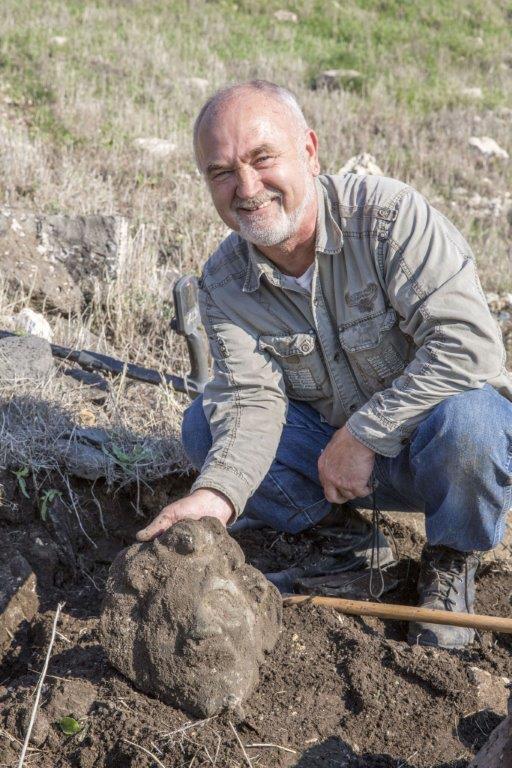 A. Iermolin unearthing the Pan mask (photo M. Eisenberg).
A. Iermolin unearthing the Pan mask (photo M. Eisenberg).
________________________________________________
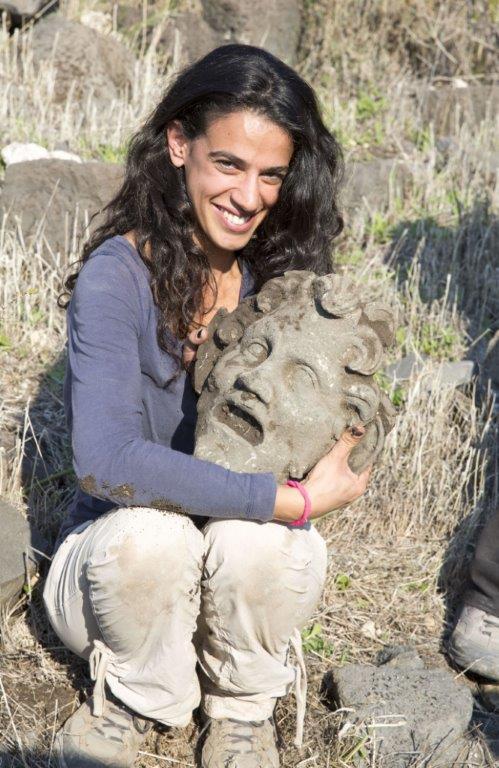 N. Shamir, Haifa team member, holding the mask just after it was unearthed (photo M. Eisenberg).
N. Shamir, Haifa team member, holding the mask just after it was unearthed (photo M. Eisenberg).
___________________________________________________
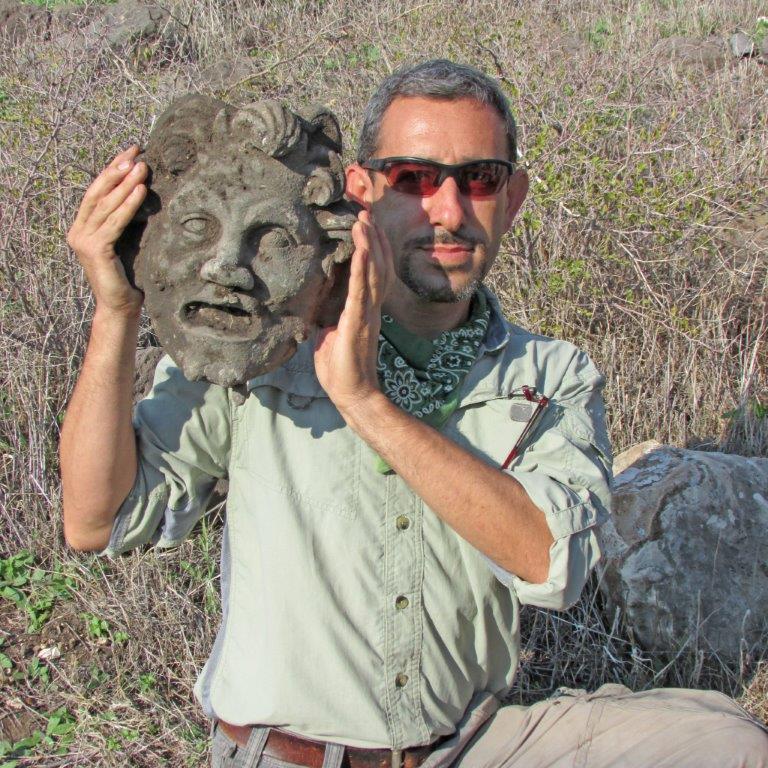 Author holding the mask just after it was unearthed. This shows more directly the comparative sizes of the mask and a human face. (photo. M. Hecht).
Author holding the mask just after it was unearthed. This shows more directly the comparative sizes of the mask and a human face. (photo. M. Hecht).
____________________________________________________
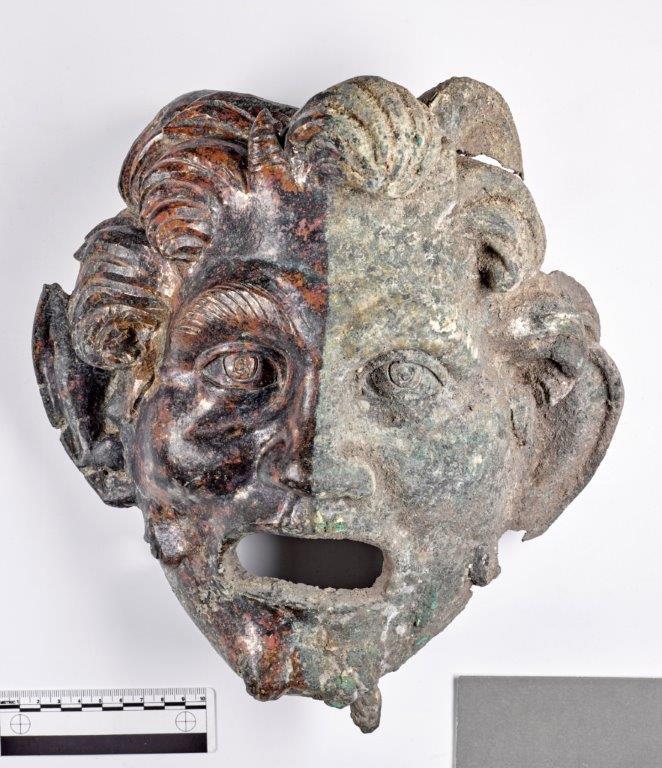 The mask after it was half way cleaned (photo M. Eisenberg).
The mask after it was half way cleaned (photo M. Eisenberg).
___________________________________________________
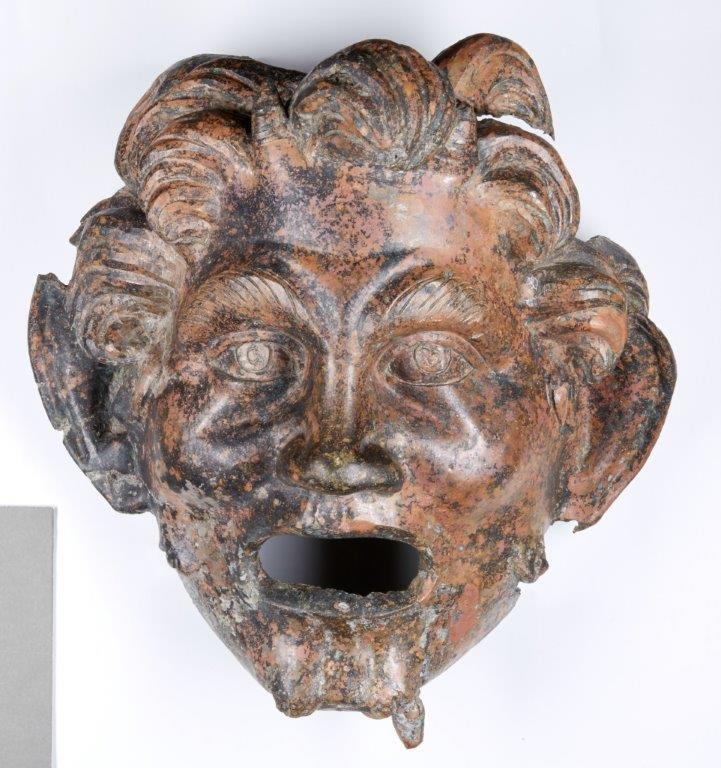 The mask after its full cleaning and before final conservation treatment (photo M. Eisenberg).
The mask after its full cleaning and before final conservation treatment (photo M. Eisenberg).
______________________________________________________
The Roman Basilica
The basilica is the main public building found in every Roman city and is usually erected adjacent to the open plaza of the forum to serve as its roofed alternative when weather conditions made it necessary. The basilica served not only as a shopping area and center for public administration, but also for the tribunal (the seat of the magistrate).
During the most recent seasons, we have almost fully unearthed the basilica at Hippos. Its construction is dated to the end of the 1st century CE and its destruction to a 363 CE earthquake. During the last season, Haim Shkolnik, the area supervisor and his team, found some tragic evidence of the destruction of the basilica. Two skeletons on the northern side of the basilica were discovered with some of the roofing and roof-tiles above, suggesting their demise resulting from the collapse of the roof during the earthquake. One of them, a woman, was still wearing her golden dove-shaped pendant, found near her neck.
_________________________________________
 The basilica and the northeast corner of the forum (photo M. Eisenberg).
The basilica and the northeast corner of the forum (photo M. Eisenberg).
____________________________________________________
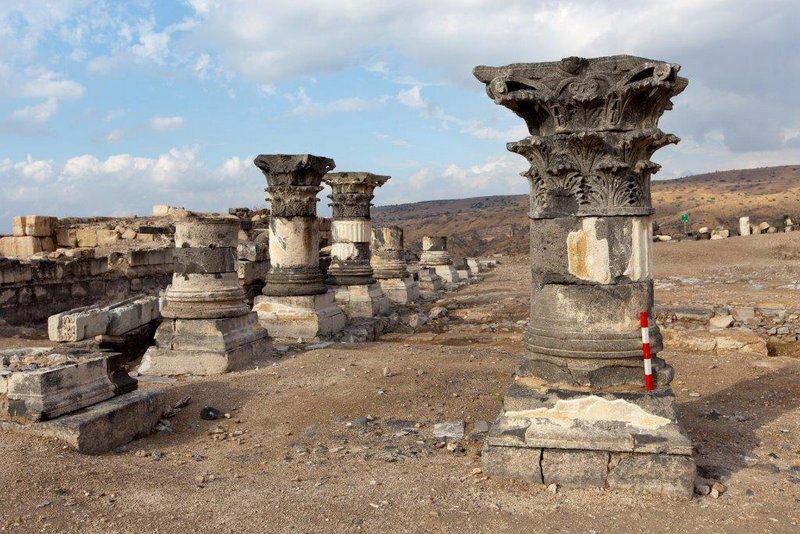 The basilica main nave and western aisle with partially reconstructed columns (photo M. Eisenberg).
The basilica main nave and western aisle with partially reconstructed columns (photo M. Eisenberg).
____________________________________________________
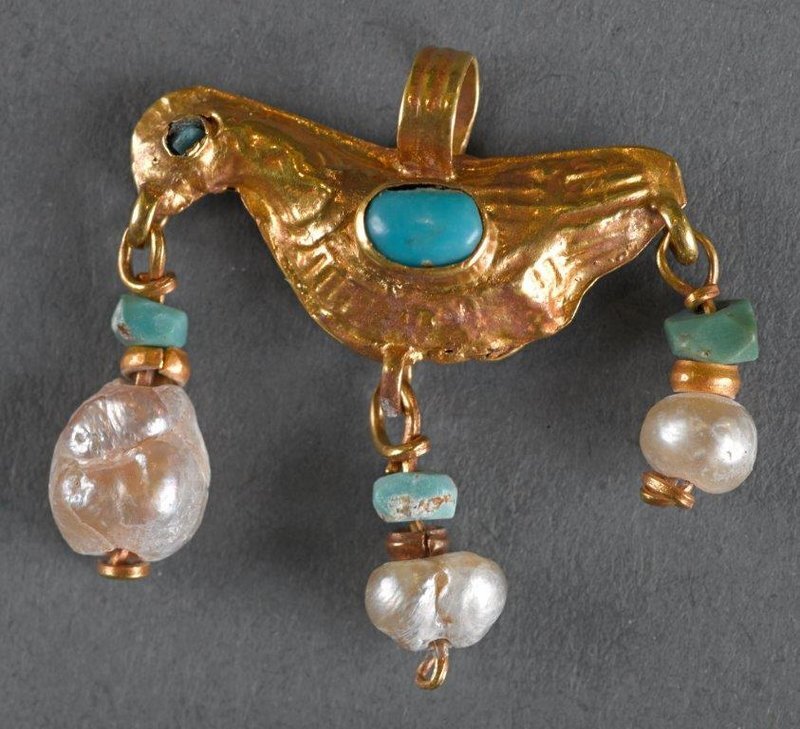 The golden pendant in the shape of a dove.
The golden pendant in the shape of a dove.
___________________________________________________
The Bastion
Hippos’ fortifications system is among the most intriguing and elaborate in the region. Though the mountain is naturally well protected by cliffs and sharp slopes, the defenders, during early Roman times, chose not only to surround the crest with a fortification wall and towers but also built an elaborate outwork system consisting of additional fortification walls, a ditch in the center of the saddle ridge, and a series of adjacent protective artillery posts. Among the defensible features, the bastion is no doubt the most unique and impressive. Built over and protruding from the center of the southern cliff, it is the main defensive and firing position along the southern fortification line of the city. The bastion has a rectangular plan, 47m in length and 8m wide, composed of a series of five vaulted chambers and a tower amongst them that supported each other and created a solid and uniform expanse for the upper fortifications, which did not survive. From here most of the firepower was directed toward the most threatening area for Hippos, which was in the direction of the stream flowing south of the mountain and along which passed the ancient road. The series of vaults and especially the opening built into at least one of the chambers, raises the possibility that they served as defensive positions for the heavy launchers. Such a launcher (ballista) of 8m long could have lunched a basalt ball of about 18 kg to a distance of 350m, and indeed some of those basalt balls have been found nearby.
On the ancient binding material of the bastion rear wall, we noticed to our great surprise a number of imprints that were left by Roman military boots while their owners were walking over the mortar before it had dried. To be more precise, there were several imprints made by the iron nails (hobnails) of caligae soles—the standard footwear of the Roman army from the 1st century BCE until the beginning of the 2nd century CE (from the ordinary soldier up to the level of centurion). One complete sole imprint was discovered as well as other partial imprints. The complete imprint was 24.50cm long and had 29 round impressions. It was a left foot caliga, approximating a European size 40. During the last season, Adam Pazout and his team exposed the block entrance of the fourth chamber vault and initiated the excavation of the fifth, most eastern chamber vault.
The bastion and its imprints raise the possibility that Roman cohorts or auxiliary stationed in Syria were also in charge of building the bastion. This is an exceptional case and probably occurred during a time of emergency. Such an emergency may have been in connection with the Great Revolt in the Galilee (66-7 CE).
__________________________________________
____________________________________________________
 The western corner of the bastion over the southern cliff. Y. Vitkalov is pretending to support the basalt beam foundations exposed after the mortar had washed away (photo M. Eisenberg).
The western corner of the bastion over the southern cliff. Y. Vitkalov is pretending to support the basalt beam foundations exposed after the mortar had washed away (photo M. Eisenberg).
_________________________________________________________
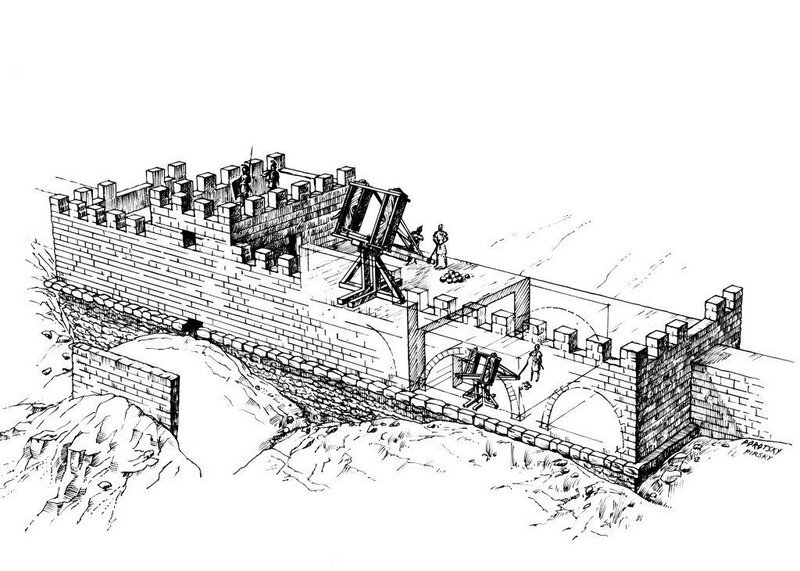 The bastion. A suggested reconstruction (drawn by D. Porotski, V. Pirsky and M. Eisenberg)
The bastion. A suggested reconstruction (drawn by D. Porotski, V. Pirsky and M. Eisenberg)
______________________________________________________
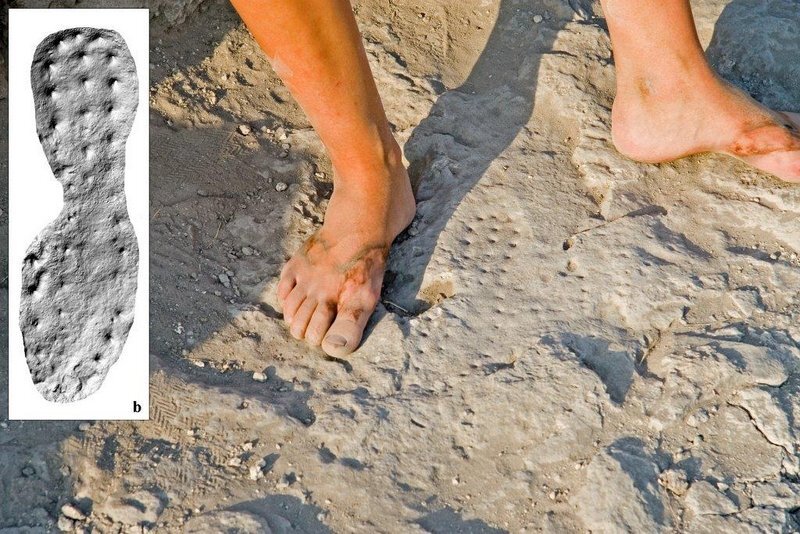 The complete caliga imprint on the rear wall of chamber Vault IV and (b) 3D scanning of its cast (photo M. Eisenberg).
The complete caliga imprint on the rear wall of chamber Vault IV and (b) 3D scanning of its cast (photo M. Eisenberg).
_____________________________________________________
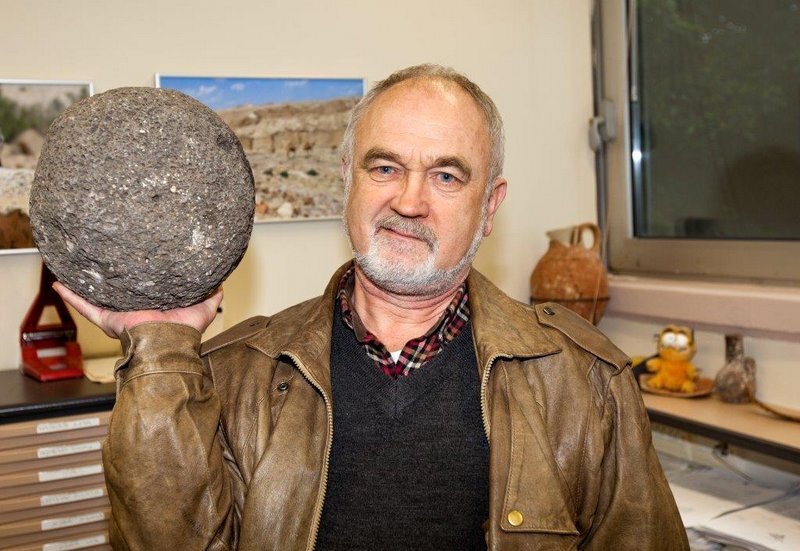 A. Iermolin, the team’s small finds conservator, holding a 42 minae (18.5 kg.) basalt ballista ball (photo M. Eisenberg).
A. Iermolin, the team’s small finds conservator, holding a 42 minae (18.5 kg.) basalt ballista ball (photo M. Eisenberg).
_____________________________________________________
The Southern Bathhouse
Like any Roman polis, Hippos had public bathhouses, one of which is located east of the forum. It is not yet excavated. The other lies south of the forum. The southern bathhouse is built over the ruins of the bastion on the southern cliff, enjoying the western breeze and overlooking the spectacular panorama of the Sea of Galilee, the Galilee and the Jewish city of Tiberias on the west side of the lake. While only the palaestra (open court for exercises), natatio (pool) and some caldaria (hot rooms) have been exposed so far, the bathhouse yielded several surprises. During some major renovations of the 3rd cent. CE, a narrow gap was left between two of the bathhouse walls. In this gap we found hundreds of ceramic vessels and terracotta lamps dating to the mid-3rd cent. CE, as well as a unique relief in stucco of a Heracles bust. During the last season, while clearing the debris of a collapsed caldarium vault of the 363 earthquake, Arleta Kowalweska, the area supervisor and her team, found part of a Roman statue. It is of superb Roman craftsmanship made out of marble, but is only the right leg of a muscular man leaning against a trunk. The statue must have been above 2m tall but without any additional attributes it would be impossible to identify it as a specific god or athlete. We hope to find more of its pieces in the coming seasons.
We realize now that the 363 CE earthquake left Hippos in its debris for a period of about 20 years. Some of the main public buildings, such as the basilica, odeion and southern bathhouse, were never rebuilt.
_________________________________________
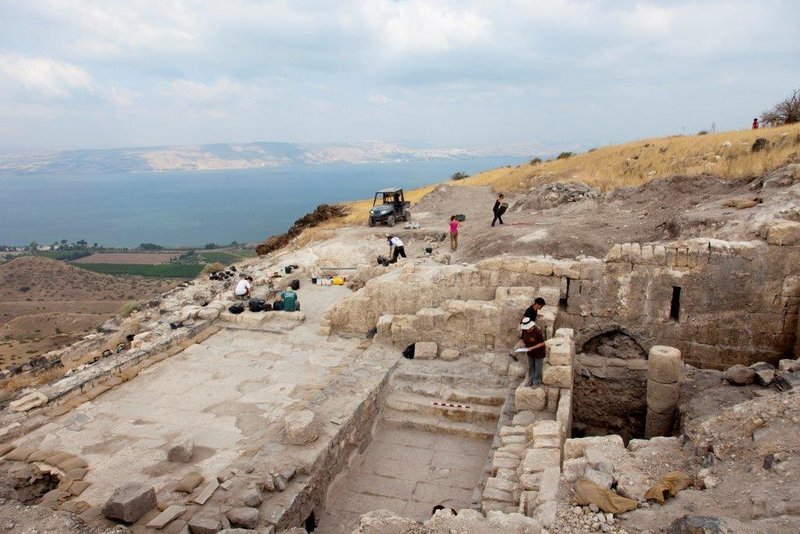 The southern bathhouse looking towards the Sea of Galilee. The palestra, natatio and one of the caldaria are well seen (photo M. Eisenberg).
The southern bathhouse looking towards the Sea of Galilee. The palestra, natatio and one of the caldaria are well seen (photo M. Eisenberg).
______________________________________________________
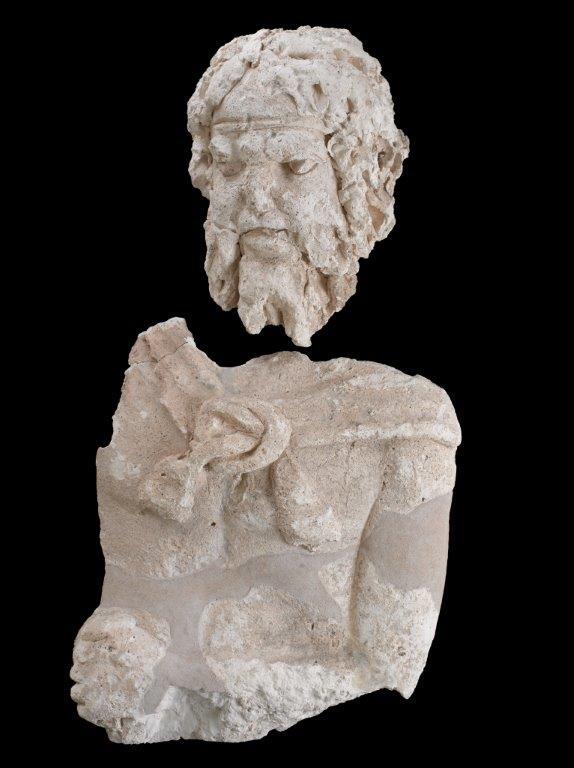 A stucco relief bust of Heracles after conservation (photo M. Eisenberg, conservation A. Iermolin).
A stucco relief bust of Heracles after conservation (photo M. Eisenberg, conservation A. Iermolin).
_______________________________________________________
 Team members Anna and Caro, just minutes after unearthing a piece of a Roman statue at the southern bathhouse (photo M. Eisenberg).
Team members Anna and Caro, just minutes after unearthing a piece of a Roman statue at the southern bathhouse (photo M. Eisenberg).
____________________________________________________
The Umayyad Caliphate
Hippos’ status as the capital of the region soon disappeared after the Byzantine period. Tiberias (Ṭabariya), on the western side of the lake, became the capital of local province Jund al-Urdunn of the Umayyad Caliphate. The decline in Hippos’ urban life was well felt already during the late Byzantine period (6th-7th centuries) and in the 8th century it was no longer a city, but an industrial town. The public area of the forum, and mainly that of the Hellenistic Compound, turned into an industrial zone. A large winery complex, olive press and large bakery were excavated here. Some other parts of the city were abandoned and the question of whether the famous water supply system was still active during the first half of the 8th century is being studied. The earthquake of January 18, 749 CE, was the ‘last straw’ for the city’s life. It was abandoned, never again to be re-settled.
_________________________________________
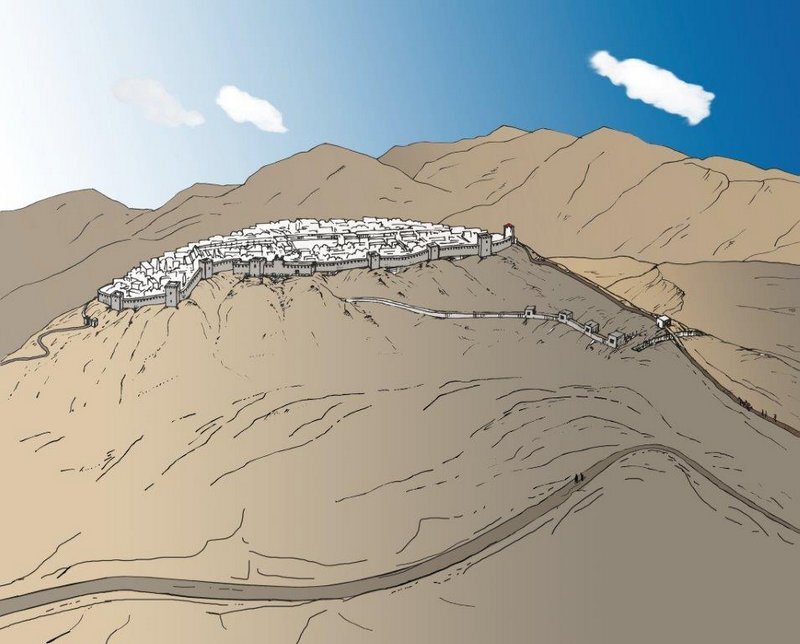 An artistic reconstruction of Hippos during the Roman Period, including the ancient road, the ditch at the saddle ridge and a series of hangars next to it (drawn by D. Porotski, V. Pirsky, M. Eisenberg and A. Regev-Gisis).
An artistic reconstruction of Hippos during the Roman Period, including the ancient road, the ditch at the saddle ridge and a series of hangars next to it (drawn by D. Porotski, V. Pirsky, M. Eisenberg and A. Regev-Gisis).
______________________________________________________
Sussita Mountain is an officially declared national park under the supervision of the National Parks Authority of Israel. Its location along one of the main tourist and pilgrimage routes on the eastern side of the Sea of Galilee makes it one of the most prominent archaeological parks in the north of Israel.
The Hippos excavation is an international enterprise, welcoming dig participants from all over the world. For more information about participation, see: http://hippos.haifa.ac.il. See also the Hippos-Sussita Excavations Project facebook page for updates and images.
_________________________________________





